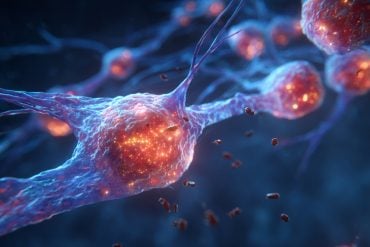Summary: Researchers have identified a protein, TMEM16F, that appears to aid the spread of Parkinson’s pathology in the brain. They found that a mutation in this protein promotes the secretion of a harmful form of α-synuclein, which moves through nerve cells, forming toxic Lewy bodies.
Mice without the TMEM16F gene showed reduced spread of Parkinson’s pathology, suggesting this protein as a potential therapeutic target. The mutation, common among Ashkenazi Jews, could provide insights into genetic risk factors and future interventions. By possibly inhibiting TMEM16F, researchers hope to slow the spread of Parkinson’s.
Key Facts:
- TMEM16F mutation increases secretion of toxic α-synuclein, accelerating Parkinson’s spread.
- Mice lacking TMEM16F showed reduced α-synuclein pathology spread.
- Findings suggest TMEM16F as a target for potential Parkinson’s treatments.
Source: Tel Aviv University
Researchers at Tel Aviv University (TAU) discovered a new factor in the pathology of Parkinson’s disease, which in the future may serve as a target for developing new treatments for this terrible ailment, affecting close to 10 million people worldwide.
The researchers: “We found that a variant of the TMEM16F protein, caused by a genetic mutation, enhances the spread of Parkinson’s pathology through nerve cells in the brain.”

The study was led by Dr. Avraham Ashkenazi and PhD student Stav Cohen Adiv Mordechai from the Department of Cell and Developmental Biology at TAU’s Faculty of Medical and Health Sciences and the Sagol School of Neuroscience. Other contributors included: Dr. Orly Goldstein, Prof. Avi Orr-Urtreger, Prof. Tanya Gurevich and Prof. Nir Giladi from TAU’s Faculty of Medical and Health Sciences and the Tel Aviv Sourasky Medical Center, as well as other researchers from TAU and the University of Haifa. The study was backed by the Aufzien Family Center for the Prevention and Treatment of Parkinson’s Disease at TAU.
The paper was published in the scientific journal Aging Cell.
Doctoral student Stav Cohen Adiv Mordechai explains: “A key mechanism of Parkinson’s disease is the aggregation in brain cells of the protein α-synuclein (in the form of Lewy bodies), eventually killing these cells.
“For many years researchers have tried to discover how the pathological version of α-synuclein spreads through the brain, affecting one cell after another, and gradually destroying whole sections of the brain.
“Since α-synuclein needs to cross the cell membrane in order to spread, we focused on the protein TMEM16F, a regulator situated in the cell membrane, as a possible driver of this lethal process.”
At first, the researchers genetically engineered a mouse model without the TMEM16F gene, and derived neurons from the brains of these mice for an in-vitro cellular model. Using a specially engineered virus, they caused these neurons to express the defective α-synuclein associated with Parkinson’s and compared the results with outcomes from normal brain cells containing TMEM16F.
They found that when the TMEM16F gene had been deleted, the α-synuclein pathology spread to fewer healthy neighboring cells compared to the spread from normal cells. The results were validated in-vivo in a living mouse model of Parkinson’s disease.
In addition, in collaboration with the Neurological Institute at the Tel Aviv Sourasky Medical Center, the researchers looked for mutations (variants) in the TMEM16F gene that might increase the risk for Parkinson’s disease.
Dr. Ashkenazi explains: “The incidence of Parkinson’s among Ashkenazi Jews is known to be relatively high, and the Institute conducts a vast ongoing genetic study on Ashkenazi Jews who carry genes increasing the risk for the disease. With their help, we were able to identify a specific TMEM16F mutation which is common in Ashkenazi Jews in general, and in Ashkenazi Parkinson’s patients in particular.”
Cells carrying the mutation were found to secrete more pathological α-synuclein compared to cells with the normal gene. The researchers explain that the mechanism behind increased secretion has to do with the biological function of the TMEM16F protein: the mutation increases the activity of TMEM16F, thereby affecting membrane secretion processes.
Stav Cohen Adiv Mordechai: “In our study, we discovered a new factor underlying Parkinson’s disease: the protein TMEM16F, which mediates secretion of the pathological α-synuclein protein through the cell membrane to the cell environment.
“Picked up by healthy neurons nearby, the defective α-synuclein forms Lewy bodies inside them, and gradually spreads through the brain, damaging more and more brain cells. Our findings mark TMEM16F as a possible new target for the development of effective treatments for Parkinson’s disease.
“If, by inhibiting TMEM16F, we can stop or reduce the secretion of defective α-synuclein from brain cells, we may be able to slow down or even halt the spread of the disease through the brain.”
Dr. Ashkenazi emphasizes that research on the new Parkinson’s mechanism has only begun, and quite a number of questions still remain to be explored: Does inhibiting TMEM16F actually reduce the symptoms of Parkinson’s disease? Does the lipid composition of cell membranes play a part in the spread of the disease in the brain? Is there a link between mutations in TMEM16F and the prevalence of Parkinson’s in the population?
The research team intends to continue the investigation in these directions and more.
About this Parkinson’s disease and genetics research news
Author: Noga Shahar
Source: Tel Aviv University
Contact: Noga Shahar – Tel Aviv University
Image: The image is credited to Neuroscience News
Original Research: Open access.
“TMEM16F regulates pathologic α-synuclein secretion and spread in cellular and mouse models of Parkinson’s disease” by Avraham Ashkenazi et al. Aging Cell
Abstract
TMEM16F regulates pathologic α-synuclein secretion and spread in cellular and mouse models of Parkinson’s disease
One of the main hallmarks of Parkinson’s disease (PD) pathology is the spread of the aggregate-prone protein α-synuclein (α-syn), which can be detected in the plasma and cerebrospinal fluid of patients as well as in the extracellular environment of neuronal cells.
The secreted α-syn can exhibit “prion-like” behavior and transmission to naïve cells can promote conformational changes and pathology. The precise role of plasma membrane proteins in the pathologic process of α-syn is yet to be fully resolved.
The TMEM16 family of lipid scramblases and ion channels has been recently associated with cancer and infectious diseases but is less known for its role in aging-related diseases.
To elucidate the role of TMEM16F in α-syn spread, we transduced neurons derived from TMEM16F knockout mice with a reporter system that enables the distinction between donor and recipient neurons of pathologic α-synA53T.
We found that the spread of α-synA53T was reduced in neurons derived from TMEM16F-knockout mice. These findings were recapitulated in vivo in a mouse model of PD, where attenuated α-synA53T spread was observed when TMEM16F was ablated.
Moreover, we identified a single nucleotide polymorphism in TMEM16F of Ashkenazi Jewish PD patients resulting in a missense Ala703Ser mutation with enhanced lipid scramblase activity.
This mutation is associated with altered regulation of α-synA53T extracellular secretion in cellular models of PD.
Our study highlights TMEM16F as a novel regulator of α-syn spread and as a potential therapeutic target in synucleinopathies.






